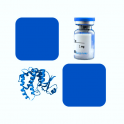
- Remove this product from my favorite's list.
- Add this product to my list of favorites.
Products
Viewed products
Newsletter
 |  |  |  |  |  |

Background
V-set and immunoglobulin domain containing 8 (VSIG8), also known as C1orf204, is a type I transmembrane protein of the B7 family within the Ig superfamily. VSIG8 was identified from proteomic analysis of human hair shafts. It is expressed in the hair follicle and shaft, superficial layers of the nail matrix, and superficial layers of oral epithelium.
Source
Recombinant human VSIG8 protein, His tag (VS8-H52H1) is expressed from human 293 cells (HEK293). It contains AA Val 22 - Gly 263 (Accession # NP_001013683.1).
Predicted N-terminus: Val 22
Molecular Characterization
This protein carries a polyhistidine tag at the C-terminus.
The protein has a calculated MW of 29.0 kDa. The protein migrates as 30 kDa under reducing (R) condition (SDS-PAGE) due to glycosylation.
Endotoxin
Less than 1.0 EU per μg by the LAL method.
Purity
>95% as determined by SDS-PAGE.
Formulation
Lyophilized from 0.22 μm filtered solution in 20 mM NaAC, 150 mM NaCl, pH4.0. Normally trehalose is added as protectant before lyophilization.
Reconstitution
Please see Certificate of Analysis for specific instructions.
For best performance, we strongly recommend you to follow the reconstitution protocol provided in the CoA.
Storage
For long term storage, the product should be stored at lyophilized state at -20°C or lower.
Please avoid repeated freeze-thaw cycles.
This product is stable after storage at:
-20°C to -70°C for 12 months in lyophilized state;
-70°C for 3 months under sterile conditions after reconstitution.
Bioactivity
Please refer to product data sheet.
(1) "Identification of genetic profile and biomarkers involved in acute respiratory distress syndrome"
Cao, Li, Xin et al
Intensive Care Med (2024) 50 (1), 46-55
(2) "A small molecule inhibitor of VSIG-8 prevents its binding to VISTA"
Chen, Qie, Hu et al
Invest New Drugs (2022) 40 (4), 690-699
(3) "VSIG-3 as a ligand of VISTA inhibits human T-cell function"
Wang, Wu, Manick et al
Immunology (2019) 156 (1), 74-85
Showing 1-3 of 5 papers.
Follow us